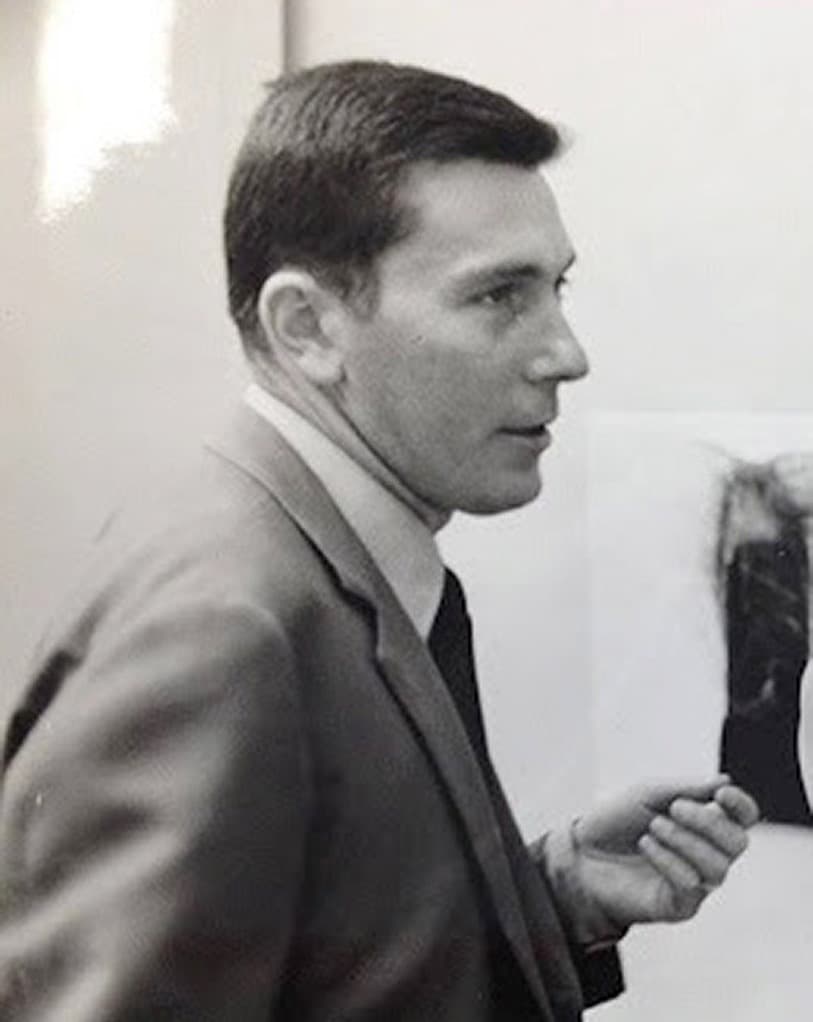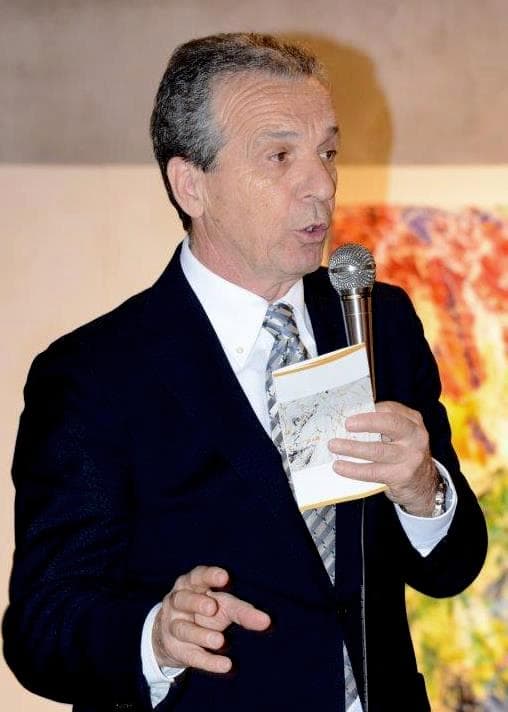
The works of Antonio Sgarbossa are characterised by a meticulous and exactly defined realism
which leaves no room for taking notice of an objective reality.
The artist uses oils on wood with surprising expertise, faithfully recreates the play and contrasts of natural light, which lightly touches people and architectural prospects, illuminating their intrinsic harmony.
Sgarbossa accosts his puts pigments without being excessive, leaving the painting to tell of silent dialogues in a narrative dimension which never transcends the allusiveness of hyper-realism .
He places, therefore, the observer in front of a situation of absolute recognisability, where the attention to details, the postures and shadows confer psychological depth to the visual story.
Paolo Levi
Vittorio Sgarbi states that to be Art a work must offer a new way of looking at reality.
Mallarmè hazarded a definition “it is the dark side of the moon”, Antonio Sgarbossa understood. In Art, we are looking for something which is beyond the sensible, beyond a phenomenal vision, almost a mirror image of ourselves.
So, here are Sgarbossa’s paintings which invite us to see beyond, full of suggestions, soft in their chromatic harmonies, with a flair for choosing the slant of an image, always ready to capture us completely and let us dream.
Sgarbossa (and it’s easy to see) comes from a long line of pictorial schooling.
He has recently produced some very finely painted pictures with inserts with original aspects on a number of different subjects.
We see and see more, in the sense that we enter into the mobile mechanism of the picture allowing ourselves to be transported by our sensations: until the picture becomes “our” mirror of our culture, our sensitivity, our way of interpreting today’s world.
It is worth observing his works in depth: enjoying the suggestive magic which issues from them ..… who knows: it could well be the dark side of the moon that we have always yearned to see.
Paolo Rizzi


Spatial Rhythms
The individual path of an artist has its moments of smooth running and short flashes of problematic thoughts, sometimes dictated by an urgency felt intensively with powerful motivation to achieve coherence dictated from within and to give an immediate reply to its signals. In the verisimilitude of his figures, Antonio Sgarbossa reveals the primary tension to the truth, understood as the affirmation of sensibility when confronted with things, people and the events he sees. In his poetics, reality and symbol, illusion and metaphor sometimes permeate each other so as to overlap in a unique, significant destination: beauty and youth, harmony and rhythm, attention to the simplest gestures. They reveal deeper impulses, settings which demand an immediate, articulate development, a wait experienced as a prelude to unknown events, the dance whose energy is liberated in the meeting of two interpretations of the space-time of music.
The dreamlike and introspective dimension of his work has expanded further in the most recent phase of his painting, where woman is the driving force and inspiring keystone of every adventure of the imagination in which the viewer can also participate. A picture is a slice of theatre, where the main character (sometimes pictured with a partner) expresses the eloquence of the self in the silence of the scene, entrusted to the articulation of the body, connected to the effects of variable highlights. In such a setting, the place of containment of the sequence is something indefinite, which may suggest the idea of a very long field, where the limits disappear into the penumbra, or an imagined landscape to balance the relationship between the indistinct and the definite.
Enzo Santese
The sun inside
Sgarbossa conceives his painting as an authentic co-penetration of the moment in which, in the silence of the scene, sunlight reveals the intimate secrets of passions and very private interior states. His celebrated ballerinas, represented in an intensity of chiaroscuro with remarkable effect, offer the marvellous contemplation of the form of the body and its delicate gracefulness which shows itself through the mastering of an art – in this case dance – that is ontological language and seductive expression. The incomparable charm of the pictures of this careful and sensitive painter are often transferred from the human figures seen in glimpses of daily life to those lonely, quiet afternoons when the absence of man gives way to bicycles diligently parked in the town or to the dignified architecture of the old town centre. Sgarbossa is always attentive, always engaged and engaging himself. His warm, hyper-realism is poetry painted, a dimension of the heart in which the exquisite nectar of Life is revealed on sunny days.
Giancarlo Bonomo


Memory Blanks
When we are faced for the first time with a work from an artist unknown to us, we feel the need to go back and define the meaning of the word art and inevitably the horizons of that term expand until they become identified with the sense of life.
The free expression of feelings, art is today a representation and, at the same time, a source of vital energy for those relating to it and thus, like our daily routine, each time it places us in front of new manifestations, it induces ever changing emotions and thoughts.
This is what happens when you come across one of Antonio Sgarbossa’s works. A refined painter, he ably combines a certain objective, photographic vision with a new, intimate interpretation of the surrounding world.
While the feminine world, which he has represented for a long time, highlights his absolute mastery of the art, it is owing to a certain indefiniteness, that slow flow of time, the detachment from concrete action and the rarefied, powdery atmospheres, subject of the Roman exhibition, that we become involved completely.
These are the ideal works/vessels for thoughts we have been brooding over at length and from which we need a break. Generated by a remarkable interior richness and from evident mastery of painting, they have the magic power to capture and reawaken, by means of particularly fascinating prospective slants and a knowledgeable management of light, those sensibilities present even in a less attentive observer. Expression of a time from which the present seems to be absent, Sgarbossa’s silent scenarios offer a ready harbour for a thousand unexpressed stories from the past, hidden memories of shared lives.
The representation of an existence punctuated by highs and lows, the places depicted appear to be characterised by clues, which leave the task of narration to others. Scenarios with “memory blanks” waiting on the walls for those who have a story to tell.
Giuseppe Salerno
Painting light
I love to define A. Sgarbossa’s paintings as Painting light.
A bright, luminous source wraps around that which the artist wants to highlight in just the right measure. Objects, streets, interiors, parts of a figure are made to stand out, captured by a more or less intense light, at times so suffused as to emanate a veiled lyricism, at others violent, but warm as the summer sun, or again like a landscape at night, it can take on mysterious valences, almost disquieting.
The figurative genre, in which Sgarbossa’s works can be collocated, is extreme modernity, adhering to the temporary reality which surrounds us, careful to catch the details – both internal and external – which might be missed by a hurried look. He depicts our society, people in the street, the loneliness of the metropolis, the markets, the avenues, suggestions also from hidden, teeming nightlife.
The painting of colours is very tense, with no smearing whatsoever; he uses oils on wood. The concreteness of the picture allows for a transparency which confers a very subtle mystery to the meaning of the picture itself. His are images capable of exciting emotions, memories; they are images that invite you to rediscover domestic affection, an historical memory of things and habits which have been lost, even personal memories of one who has lived in a more human and authentic context. Still, his works can also astonish, thanks to their original, often unusual slant.
This is precisely where Sgarbossa’s ability lies: although he remains loyal to the figurative essence of representation, he does, however, suggest it in a current, modern key. His expressive modules encapsulate the continuity of the great figurative tradition of Italian art, in his very own expressive style.
Piera Piazza


EMOTIONS
On an artistic level, we are practically involved in a progressive evolution from descriptions of animals and objects to places and human faces or figures with their own personal and social characteristics, their rank and even explicitly economic condition (as in the case of the Arnolfini marriage). In the meantime, the pure state of mind of the artist is projected into all these productions and it can then be read or deciphered in the work represented.
With the advent of photography, the relationship between the things described and the connected emotions dissolved, and the interlacement with the concrete portrayal disappears; the informal is born, the non-figurative, abstract sign that is free from reality to allow only the spirit of the painter to emerge and be described, his inner self, both emotional and intellectual.
Sgarbossa renovates the old relationship with the material object, offering therefore the objective photographic portrait while recovering at the same time the more intimate and human side of the painting and himself, indicated just with a symbol.
Indeed, it is so precise that it is almost over refined, I would even say mathematical, or Pythagorean in the harmony of details where in the overall picture you can discover the minutest forms similar to or twinned with those of the larger picture. In a certain sense the minor forms give substance to the wider vision in a play of mirrored reflections, in a see-saw of surfaces and reverberations to find in each niche the pulsation of the area which contains it.
And it is this which emblematically Sgarbossa creates, for example, in the portrait of the Bracco’s two puppies, their bodies, suitably close to each other, draw the outline of a heart which ideally unites them and brings out in us our own puppy-like instincts, our own most tender instincts when being born or just born. These are the most innocent and spontaneous early, carnal ties, surfacing like the dawn of the birth of acculturation or reason. The Master becomes then the lord of the symbols delicately hidden yet simultaneously visible in their synchrony, in the to and fro between the internal and external, between the allusive and explicit, in the geography of the earth and in those secrets of interior maps. In this way the articulation of the marks reveal the manifest and occult filigree of the sentiments in their dialogue to let us find harmony in complexity and sometimes contradictoriness within ourselves.
In synthesis, without letting it be seen, that agreement or consonance of correspondence becomes a very evident meeting of impulses and pulsations to suggest the basic message which underlines the very heart of our relationships, our need for love.